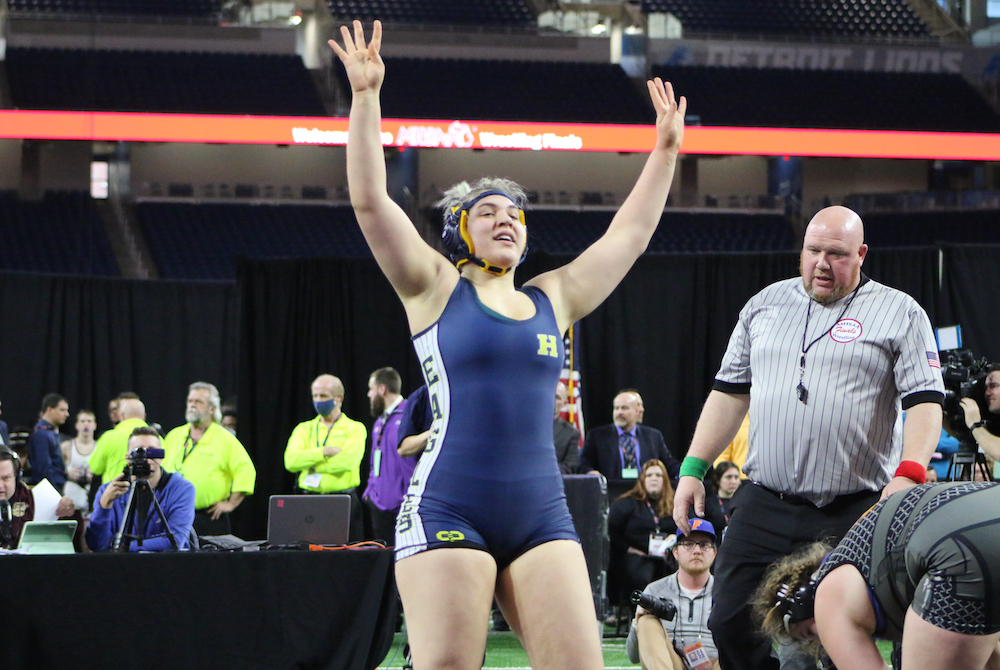
1st Girls Finals Champions Make MHSAA History at Ford Field
By
Scott DeCamp
Special for MHSAA.com
March 6, 2022
DETROIT – Eliana Bommarito will typically have the advantage in strength anytime she steps on the wrestling mat against another female.
At Saturday’s Individual Wrestling Finals, the Hartland senior drew strength from the crowd at Ford Field as girls joined the boys on the big stage for the first time in history.
Bommarito earned a fall over Belding freshman Madasyn Frisbie in 3:53 in the 255-pound title match to become a four-time state champion.
“I’m so proud. It means, like, we’re being recognized,” said Bommarito, who was 8-0 in matches against girls this season. “There’s actually more girls joining, and this will only encourage more and more females to start wrestling and know that they have a chance to be recognized for it. It’s just great that I got to see that my last year.”
Bommarito said she picked up wrestling about six years ago. She’s been a state champion more than half that time.
The last three years, she won state titles through the Michigan Wrestling Association. This season, a girls wrestling tournament was sponsored by the Michigan High School Athletic Association, so Bommarito got the chance to perform in front of a much larger crowd that in previous years.
Frisbie (7-1) made Bommarito work a bit. None of the previous postseason matches in her career went beyond the first period, but this one lasted nearly two.
“I rely a lot on my upper-body strength. I always get discouraged when I get in a match and I don’t have that (advantage). But that’s definitely something that I have the majority of the time,” Bommarito said. “Going to that second period, I was like, ‘She’s pretty good. It’s going to work up my cardio a bit for this match, so I’ve got to start relying on cardio, too.’
“This is great. It’s like the first time in history for women (to wrestle alongside the boys at the Finals), in at least Michigan. I feel like I can encourage more females to want to join wrestling.”
100
Champion: Emme Hicks, Saline, Jr. (10-0)
Fall, 5:50, over Tricia Pyrzewski, Gladwin, Soph. (13-3)
Hicks earned her third state title in as many high school seasons with the hard-fought victory over Pyrzewski.
Hicks picked up wrestling as a second-grader nine years ago.
“I know that I’ve put in more work than anybody else. I live on the mat, I feel some days. I trust in my coaches and my hard work,” she said.
“This just felt amazing to be recognized by so many people as being equal as the guys who wrestle. Having this opportunity, it’s just amazing.”
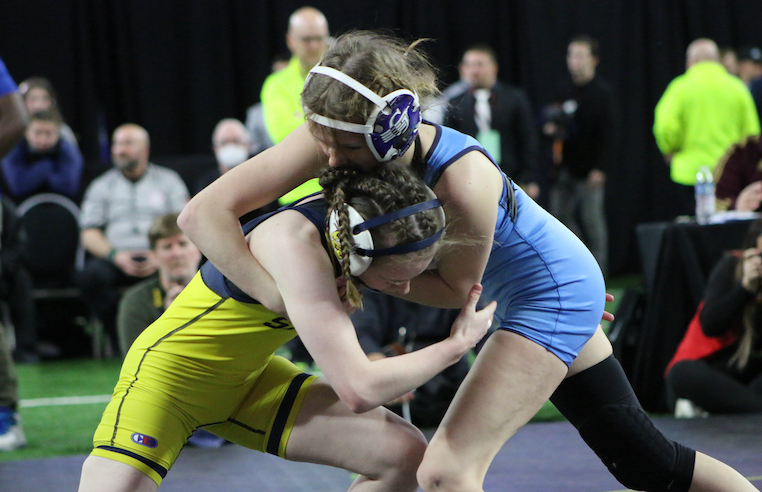
105
Champion: Sky Langewicz, Algonac, Fr. (19-0)
Decision, 3-0, over Sunni LaFond, Gaylord, Fr. (32-9)
In the lone Finals match pitting two freshmen, Langewicz shook off some nerves and recorded a hard-earned victory.
Langewicz said she’d been preparing all season for this moment, and once she scored a takedown, the rest took care of itself.
“It was scary at first – I was pretty nervous, but as soon as the whistle blew, the nerves went away and I just felt in the moment,” she said. “The whole world disappeared, and I didn’t feel like there was any pressure. It felt amazing.”
110
Sophomore Sydney Thompson, Eaton Rapids, Soph. (20-6)
Decision, 7-1, over Gabby Motz, Laingsburg, Sr. (19-5)
Thompson noticed quite the difference in atmosphere between the girls Finals last year and this weekend’s event at Ford Field. Also, she didn’t even place last year and this time she took home the state title.
“I worked hard, I put in the work, I did what needed to be done,” she said. “I did what (most) people weren’t willing to do: Staying after practice, practicing on weekends, working one-on-one with coaches and my dad and stuff. Just working hard.
“I didn’t waver. I knew it was going to pay off. I knew that if I worked hard, it would beat anyone’s talent when they didn’t work hard, so I knew I would come out on top.”
115
Margaret Buurma, Fowlerville, Fr. (14-2)
Decision, 9-6, over Kendra Vickory, Goodrich, Soph. (6-2)
Buurma trailed later in the match against Vickory but said she kept fighting to pull out the victory on the big stage.
Buurma said she’s been wrestling since she was 3 or 4 years old, but this environment was different than anything she had ever experienced.
“The experience was definitely amazing – one of the greatest things I’ve ever done,” she said. “It was very nerve-racking going out there in front of all the people, but in the end it’s the same rules, same mat.”
120
Angelina Pena, Milan, Soph. (8-0)
Fall, 5:56, over Lola Barkby, Sturgis, Fr. (8-3)
Pena believes that wrestling against boys helps her when it’s time to take the mat against a girl. At the same time, she’s very proud of the fact that girls now have an equal platform as boys at the Finals.
“It really means a lot to me,” said Pena, who won a second-straight state title. “I know a lot of my girl wrestling friends say the same thing because you used to hear boys say, ‘Oh, girls wrestling is so easy. I could totally win that.’ We get the same chance as guys do.”
Pena’s brother, Milan junior Peter Pena, finished runner-up at 140 pounds in Division 3 moments after she captured the championship.
125
Hannah Palise, Warren Mott, Sr. (22-1)
Decision, 6-3, over Ryen Allen, Goodrich, Soph. (6-1)
Palise closed her high school wrestling career in grand fashion, rallying past Allen for her first title.
Palise knew she needed a takedown and nearfall to pull out the victory. Achieving her goal in front of a large crowd in the big venue made it all the more memorable, she said.
“It was awesome – like, the whole stands, everything,” she said. “It made it more meaningful that everybody could come, that I knew that were supporting me.”
130
Tyler Swanigan, South Lyon East, Soph. (9-0)
Decision, SV-1 8-6, over Faith Blackburn, Clinton, Soph. (23-2)
At several moments during her Finals match, it appeared Swanigan could have given up. Her shoulder joints were bending so much, it seemed as though they were made of rubber bands.
“I’m a varsity cheerleader,” the flexible Swanigan said in laughter after her dramatic, extra-time victory.
Swanigan bent but didn’t break. The moment she scored a takedown in the extra period, she realized that she’d realized a dream.
“Definitely the thoughts of winning my first state title. … I definitely wanted this really bad,” she said.
135
Danni Swihart, Hanover-Horton, Jr. (20-4)
Inj. Def., 5:01, over Kennedy Edson, Lawrence, Jr. (14-1)
Swihart said she picked up wrestling in second or third grade. All the hard work paid off.
In her first Finals appearance, Swihart captured the championship and did so on the biggest stage the girls have been on.
“Oh, it was just glorious,” she said. “I mean, coming out here, working so hard during the season, having the opportunity to be in the Finals, let alone first time in girls history and at Ford Field, it was just an outstanding feeling.
“And if I could, I would play it over and over again,” she added with a chuckle.
140
Emma Pendell, Montague, Soph. (19-6)
Decision, TB-1 2-1, over Isabel Worthing, East Jackson, Sr. (13-5)
Pendell is Montague’s first girls wrestling state champion, and she’s also her school’s first Finals champ in the sport since 1989.
She placed seventh in the state last year, when she dual-sported in wrestling and basketball during the winter.
“My main reason for (picking up wrestling) was college opportunities, but after like two years, I just fell in love with it. Now, I can’t imagine not doing it,” she said.
145
Mishell Rebisch, Romeo, Soph. (8-0)
Fall, 3:55, over Teairah Elsemann, Saline, Jr., (6-2)
Rebisch admitted to feeling a little pressure with so many eyes on her during her Finals match against Elsemann. She knew when it was time to turn the pressure up on her opponent, however, and she scored a pinfall late in the second period.
Rebisch captured her first title after finishing runner-up last season.
“Definitely, there was so much more mats here – probably like five times as many mats as there was last year. Big stadium – a lot bigger stadium,” she said. “It felt a lot louder. In some ways, it felt like more pressure, probably because so many people were watching. I was excited.”
155
Lydia Krauss, Boyne City, Sr., (24-0)
Major decision, 13-2, over Amarisa Manuel, Romeo, Soph. (6-1)
A lot was riding on the Finals match for Krauss – more than the title.
“Honestly, I just wanted 100 wins – I just wanted it,” she said.
Krauss got both. Previously, she had lost twice to Manuel, including in last year’s state finals tournament. This time, she left no doubt.
“It was just amazing. I’ve lost to her twice so far and just to know that I can beat her and I can be a girl that gets 100 wins, it’s just amazing,” the emotional Krauss said. “I’m just so grateful right now.”
170
Sabrina Nauss, Brighton, Soph. (9-0)
Fall, 1:59, over Khloe Williams, Clio, Jr. (7-2)
On Friday, Nauss became the first girl to win a match at the MHSAA’s first Finals tournament.
On Saturday, she finished the job in a big way, earning a victory over Williams to cap a memorable weekend and season.
“This weekend was so special. This will be a weekend I’ll never forget in my life,” Nauss said. “It was great – it was great to be out here and prove that girls can wrestle just as hard as guys can and that we’re just as equal as they are and we should be on the mat alongside of them. This was so special.”
190
Kailyn Garrett, South Lyon, Sr. (8-1)
Major decision, 19-9, over Gabriella Allen, Marcellus, Soph. (16-1)
Garrett could not have imagined finishing her high school wrestling career in a better way.
Sure, she won her second state title in three years, but this one felt so much bigger.
“Well, first, the crowd size. And then also being able to be seen next to the guys, seen as equals, is definitely a big difference,” Garrett said. “I had people when I won (two years ago) didn’t say anything and then now even qualifying, they feel obligated to congratulate me, so that’s a big difference.”
PHOTOS (Top) Hartland’s Eliana Bommarito holds up four fingers on each hand to signify winning her fourth championship Saturday at Ford Field. (Middle) Saline’s Emme Hicks, left, locks up with Gladwin’s Tricia Pyrzewski. (Click for more from HighSchoolSportsScene.com.)
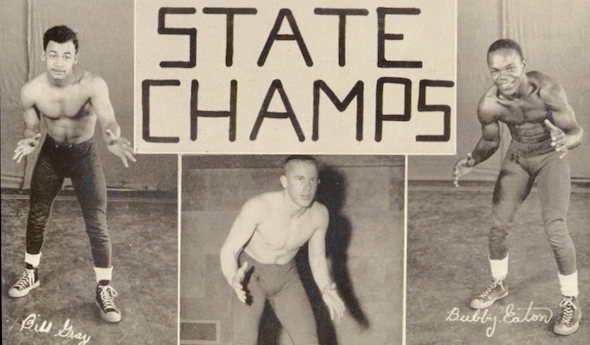
Old 5-A League Fueled Wrestling's Rise
June 29, 2020
By Ron Pesch
Special for Second Half
This latest quest into wrestling began with an inquiry, as these projects often do.
My work with the MHSAA – which includes the title ‘historian’ – is mostly a hobby that began many years ago. The diversion often gets me into press boxes and places the average sports fan doesn’t usually get to venture. Now and then, I get to talk into a microphone. But mostly, it is hours of digging; pouring through scrapbooks, yearbooks and newspapers, old and new, as I search for names, details and stories lost in time. The pursuit sometimes leads to awkward phone calls, e-mails and messages where I try to describe who I am and why I’m chasing a phone number for someone, a person’s mother or father, grandmother or grandfather.
I adore the chase and resolving mysteries. I love visiting libraries and schools and delight in connecting with people. I love filling in holes and connecting dots. I’m a computer guy by trade, focused on analyzing and aligning data. I equate sports searches to detective work, and for fans of old television, I’m like Columbo without the trench coat or cigar, always asking, “Just one more thing …”
Wrestling
My first visit to the sport was in junior high gym class. That’s when Coach Murphy paired me up against another undersized classmate. With the shrill of a whistle, we battled it out on a deep red colored mat – representative of one half of the red and grey school colors of Nelson Junior High. The struggle lasted for no more than a matter of seconds. With a slap of a mat, or perhaps another whistle, it was over. I lost by ‘fall’ – the gentler way of saying I was pinned.
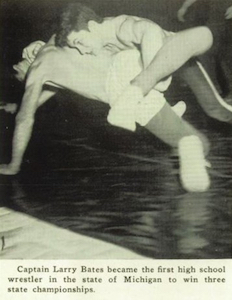 My second visit to the sport came in high school. That’s when the wrestling coach stopped me in the hall one day to suggest I join the wrestling team. Apparently, word of the skills I demonstrated at Nelson hadn’t travelled the half mile east from the junior high to the high school. Quickly recognizing this fact, I told him it might be counter-productive, as I wasn’t much of a wrestler. He was undeterred. Because I was still undersized, he said, I would likely win a fair number of matches. Many schools, it seemed, struggled to find someone to wrestle in the lower classes, and hence, would have to forfeit. I still turned him down.
My second visit to the sport came in high school. That’s when the wrestling coach stopped me in the hall one day to suggest I join the wrestling team. Apparently, word of the skills I demonstrated at Nelson hadn’t travelled the half mile east from the junior high to the high school. Quickly recognizing this fact, I told him it might be counter-productive, as I wasn’t much of a wrestler. He was undeterred. Because I was still undersized, he said, I would likely win a fair number of matches. Many schools, it seemed, struggled to find someone to wrestle in the lower classes, and hence, would have to forfeit. I still turned him down.
I give credit to the Coach Erickson. He was trying to involve a kid in athletics that wasn’t going to make the football, basketball or track team. But that bit of wisdom didn’t hit me until long after high school.
As the above may demonstrate, an extensive understanding of the intricate particulars of wrestling isn’t my strong suit. I’ve attended only one MHSAA Wrestling Final. That visit still remains among my favorite sports sights. The pageantry of the Grand March staged before the orchestrated pandemonium of the MHSAA wrestling championship combined with huge crowds and inspiring athleticism creates a spectacular event.
The Latest Project
Recently, a question, relating to past individual champions from the earliest days of the championships, arrived at the MHSAA office. The Association has awarded wrestling titles since 1948, and a list of team champions and runners-up from the beginning to the present appear on the MHSAA Website. Missing, however, are the names of the individuals who won championships between 1948 and 1960.
To find an answer, that meant a deep dive into newspapers, yearbooks and old wrestling guides to exhume the particulars from articles and agate, cross-referencing results, matching last names to first names, correcting spellings and occasionally schools when obvious errors have been made.
Technology has helped carve away some time and travel when embarking on such a project. Once, the only way to dig out such information was to travel to microfilm, and then spend hours scrolling past print. Today, thanks to some online archives, even during a global pandemic, we can visit a handful of Michigan newspapers via the internet. Tack on the ability to search the online cloud of information, intriguing elements intermittently bubble to the surface, transforming a standing list of names and schools to an account that brings at least some names to life.
The Beginnings
An initial look at the existing team championship listings revealed the first fact. For all intents and purposes, the earliest days of the MHSAA wrestling state championships served as a glorified meet for the members of the 5-A Conference. The league, comprised of Ann Arbor, Battle Creek Central, Jackson, Lansing Eastern and Lansing Sexton high schools, was where wrestling as a prep sport first gained traction in Michigan. Almost immediately, Greater Lansing established a stronghold on the sport that would last those first 13 years.
From 1948 to 1960, there was only one classification in which all schools, regardless of size, competed. In 10 of those 13 years, one of two Lansing high schools – Eastern or Sexton – won the state’s mat championship. In the three years when a Lansing team didn’t win, they finished as runner-up. Those three were part seven total of that baker’s dozen when either Eastern or Sexton finished second.
Growth in Michigan
The first championship tournament in 1948 involved around a dozen schools. While expansion into other schools commenced slowly, by 1957, wrestling had progressed into the fastest growing sport in Michigan.
“The sport blossoms into many new schools every year,” stated George Maskin in a January issue of the Detroit Times in 1957. “Best estimates are that at least 60 varsity prep teams now are in competition. The figure should come close to the 100 mark within a year or two. Prep wrestling has grown with such swiftness it now is necessary to hold regionals to determine qualifiers for the state meet.
“It is not the kind of wrestling one has watched on television or in some of the professional arenas around the state,” he added, trying to educate the public about the difference between the prep sport and the form of broadcast entertainment then popular. “Groans and grunts have no part in high school wrestling … nor does hair pulling or stamping the feet … or pointing a finger into the referee’s eye.”
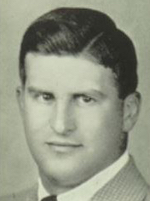 Coaches of wrestling noted that it was one of the few sports offered that gave equal opportunity to students regardless of their physical build. Separated into 12 weight classifications, running from 95 pounds and under up to the unlimited, or heavyweight division, there was a place for all.
Coaches of wrestling noted that it was one of the few sports offered that gave equal opportunity to students regardless of their physical build. Separated into 12 weight classifications, running from 95 pounds and under up to the unlimited, or heavyweight division, there was a place for all.
“Take the kid who weighs 95 pounds,” Ignatius ‘Iggy’ Konrad, a former wrestler at Michigan State and the coach at Lansing Sexton, told Maskin. “He’ll participate against a boy of similar weight. Thus a kid whose athletic possibilities might appear hopeless (in other sports) finds a place for himself in wrestling.”
As the sport continued to expand, coaches were still trying to explain the worth.
“Parents should try to understand the difference between television wrestling and high school and college wrestling,” Grandville coach Kay Hutsell told a Grand Rapids Press reporter in December 1960. “There is no comparison. TV is 100 percent acting.”
A state champion wrestler as a high school student in Illinois, where spectator interest and participation was far greater than in those early days of wrestling in Michigan, Hutsell twice lettered in the sport at Indiana University.
“Wrestling is a conditioner and perhaps develops the body better than any other sport. About the only way wrestling can educate the adults (in the western Michigan area about the sport) is through newspapers.” He felt people should come to “see for themselves.”
The Tournament
Lansing Sexton won the state’s inaugural team wrestling title, 54-43 over the Ann Arbor Pioneers, with the event run off on the mats of the University of Michigan in 1948. Both Floyd Eaton at 127 pounds and Carl Covert at 133 ended the year undefeated for the Big Reds. Five wrestlers from each school earned individual titles that first year. Jackson’s heavyweight, Norm Blank, scored a pin over Sexton’s Dick Buckmaster. The pair had split their two previous matches during league competition.
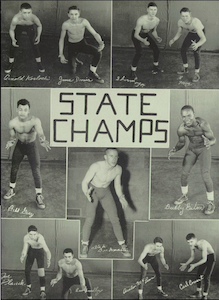 Ann Arbor grabbed the next two MHSAA team titles, both by a mere four points, first 60-56 over Sexton, then topping the Quakers of Lansing Eastern, 56-52, in 1950.
Ann Arbor grabbed the next two MHSAA team titles, both by a mere four points, first 60-56 over Sexton, then topping the Quakers of Lansing Eastern, 56-52, in 1950.
Eight wrestlers qualified for the final round for both Ann Arbor and Sexton in 1949, with five each earning championships. Both schools had three wrestlers finish in third and fourth place; hence the team title was awarded based on Ann Arbor tallying more pins. A total of 96 wrestlers from 11 schools participated in the tournament. Ted Lennox, wrestling at 95 pounds, became the first athlete from the Michigan School for the Blind to compete for an individual title but was defeated by Sexton’s Leo Kosloski. Lennox would later wrestle for Michigan State.
In 1950, nine Ann Arbor wrestlers advanced to the final round with six seizing championship medals, but only Sam Holloway repeated as champion from the previous year. Teammate Jack Townsley, who had won in 1949 at 112 pounds, finished second at 120.
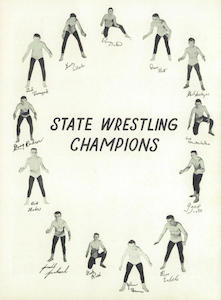 Eastern and coach Don Johnson grabbed the first of two consecutive titles in 1951, topping Ann Arbor, 56-52, with East Lansing finishing a distant third with 26 points. Pete Christ of Battle Creek Central became the first Bearcat (and only the second athlete from a school other than Eastern, Sexton or Ann Arbor) to bring home an individual wrestling title, with a decision over Lansing Eastern’s Vince Malcongi in the 140 classification. “The Bearcat matmen took fourth in the State,” according to the Battle Creek yearbook. “Mr. Donald Cooper took over the coaching duties when Mr. Allen Bush was called to the Marines.” (Bush would later serve as executive director of the MHSAA).
Eastern and coach Don Johnson grabbed the first of two consecutive titles in 1951, topping Ann Arbor, 56-52, with East Lansing finishing a distant third with 26 points. Pete Christ of Battle Creek Central became the first Bearcat (and only the second athlete from a school other than Eastern, Sexton or Ann Arbor) to bring home an individual wrestling title, with a decision over Lansing Eastern’s Vince Malcongi in the 140 classification. “The Bearcat matmen took fourth in the State,” according to the Battle Creek yearbook. “Mr. Donald Cooper took over the coaching duties when Mr. Allen Bush was called to the Marines.” (Bush would later serve as executive director of the MHSAA).
Johnson’s squad absolutely dominated the field in 1952, topping Sexton the next year, 68-43. Ann Arbor followed with 39 points. Seven Quakers – George Smith (95), Herb Austin (103), Jim Sinadinos (127) Bob Ovenhouse (133), Bob Ballard (138), Ed Cary (145) and Norm Thomas (175) – all won their final matches. Both Austin and Sinadinos were repeat champions.
Sexton flipped the table in 1953 with a 67-46 win over Eastern. Ten Big Reds competed for individual state championships among the 12 classifications, with five taking home titles. The Big Reds’ Ken Maidlow, jumping from 165 pounds to 175, and Eastern’s Ed Cary, who moved up to 154, both repeated as medal winners. In the heavyweight class, Sexton’s Ray Reglin downed Steve Zervas from Hazel Park. (Zervas, a two-time runner-up, later wrestled at the University of Michigan, then coached wrestling at Warren Fitzgerald for 34 seasons and served as mayor of Hazel Park from 1974 to 1986).
In 1954, Ossie Elliott of Ypsilanti and Henry Henson of Berkley became the first wrestlers from non 5-A schools to win individual state wrestling titles. Elliott, who had finished as state runner-up in 1953 at 133 pounds, downed Lansing Sexton’s Tom Holden in the same classification. Henson earned a decision over Lansing Eastern’s Ken Bliesener at 154 pounds. Eastern again returned to the winner’s circle, outdistancing Sexton, 60-44. Ypsilanti finished third with 34 points.
By 1955, athletes from 28 high school teams were battling for state team and individual honors on the mats at MSC’s Jenison Field House. As a senior captain, Lansing Eastern’s Larry Bates pinned four out of five opponents in the 112-pound class to become Michigan’s first wrestler to earn three state crowns. Bates grabbed his first title in 1953, competing at 95 pounds, followed by his second in 1954 at 103. Eastern picked up its second-straight team trophy, racking up 102 points on the way to a fourth crown in the eighth year of championships. For the first time, a non-5-A school finished second, as the Ypsilanti Braves grabbed runner-up honors with 84 points.
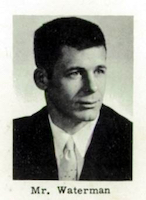 Coach Bert Waterman led Ypsilanti to the first of four championships during a 10-year span in 1956. Two Braves, Ambi Wilbanks and Walt Pipps, earned titles while three others finished second in their classifications. Ypsi had lost one dual meet during the regular season, to Lansing Eastern, by a slim three-point margin. With the 1967-68 school year, Waterman would embark on a 24-year career as coach at Yale University after posting a 192-35-4 mark in 16 seasons at Ypsilanti. A 1950 graduate of Michigan State, the former Spartans wrestler would join Eastern’s Don Johnson, Sexton’s Iggy Konrad, Fran Hetherington from the School for the Blind and two other high school coaches as a charter member of the Michigan Wrestling Hall of Fame in November 1978.
Coach Bert Waterman led Ypsilanti to the first of four championships during a 10-year span in 1956. Two Braves, Ambi Wilbanks and Walt Pipps, earned titles while three others finished second in their classifications. Ypsi had lost one dual meet during the regular season, to Lansing Eastern, by a slim three-point margin. With the 1967-68 school year, Waterman would embark on a 24-year career as coach at Yale University after posting a 192-35-4 mark in 16 seasons at Ypsilanti. A 1950 graduate of Michigan State, the former Spartans wrestler would join Eastern’s Don Johnson, Sexton’s Iggy Konrad, Fran Hetherington from the School for the Blind and two other high school coaches as a charter member of the Michigan Wrestling Hall of Fame in November 1978.
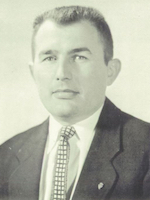 Runner-up in 1956, Eastern grabbed another title in 1957 topping Battle Creek Central, 93-89, in the tournament standings. It was a surprise “going away present” for Coach Don Johnson, who was stepping away after 10 seasons of coaching the Quakers to accept the assistant principal position at Eastern. Battle Creek had five wrestlers advance, and held a 56-48 lead over Eastern as the teams entered the final round. The Quakers’ Ted Hartman opened the day with a victory in the 98-pound weight class, helping Eastern post a 3-1 record in championship round matches. Sexton assisted with the Eastern victory when Norm Young defeated Battle Creek’s Bob McClenney in the 120 weight class. The Bearcats, who had five wrestlers in the finals, ended with two individual champs on the day and their highest finish in their 10 seasons of wrestling.
Runner-up in 1956, Eastern grabbed another title in 1957 topping Battle Creek Central, 93-89, in the tournament standings. It was a surprise “going away present” for Coach Don Johnson, who was stepping away after 10 seasons of coaching the Quakers to accept the assistant principal position at Eastern. Battle Creek had five wrestlers advance, and held a 56-48 lead over Eastern as the teams entered the final round. The Quakers’ Ted Hartman opened the day with a victory in the 98-pound weight class, helping Eastern post a 3-1 record in championship round matches. Sexton assisted with the Eastern victory when Norm Young defeated Battle Creek’s Bob McClenney in the 120 weight class. The Bearcats, who had five wrestlers in the finals, ended with two individual champs on the day and their highest finish in their 10 seasons of wrestling.
An All-American wrestler at Michigan State, Johnson would remain at Eastern throughout his education career, retiring as principal in 1983. The fieldhouse at Eastern was named after him in December 1984, fittingly just prior to the championship round of the annual Eastern High Wrestling Invitational.
Eastern again went back-to-back, topping Sexton, 88-57, with Ypsilanti third in the 1958 championship standings. The meet, culminating with 16 boys competing in each weight division – four each from regionals hosted at Battle Creek, Lansing, Ypsilanti and Berkley – was held at the Intramural Building at the University of Michigan. Both Eastern and Sexton advanced four wrestlers to the final round, with Eastern’s Gary Gogarn (95), Ron Parkinson (145) and Alex Valcanoff (154) earning titles. For Sexton, Fritz Kellerman (133) and Wilkie Hopkins (138) finished on top.
The 1959 championships, hosted at the new intramural building at MSU, found boys from 47 schools chasing medal honors.
“Points toward the team title are awarded one for each bout won, with an extra point for a fall,” noted the Lansing State Journal, explaining the mechanics of the tournament. “The big scoring chance comes (in the final round) with a first place netting 10 points, second 7, third 4 and fourth 2.”
Jackson and Sexton had tied for the 6-A Conference crown (the league renamed with the addition of Kalamazoo Central to the mix) and the race to the MHSAA title was expected to be a tight one. Jackson qualified seven for the semifinal round, with four advancing to the championships. The Big Reds sent five wrestlers to the last round. Vikings Ron Shavers (95), Nate Haehnle (145) and Don Mains (165) had each won matches, while Sexton’s qualifiers Tom Mulder (127) and Emerson Boles (175) had earned titles.
With one match remaining, Jackson trailed Iggy Konrad’s Big Reds by four, 67-63, as the Vikings’ Ed Youngs – the state’s reigning heavyweight champion – squared off with Sexton’s Mickey Devoe. Youngs grabbed a 3-1 decision to repeat, but the Vikings needed a fall in the match for a tie. Hence, the Big Reds eked out a single-point victory, 74-73, to escape with their third state mat title.
The results of the title round of the 1960 tournament, also won by Sexton, telegraphed how far the sport had come. Wrestlers from a dozen high schools squared off for honors in the title matches, with winners representing 10 cities. The Big Reds topped Ypsilanti 70-64, followed by Kalamazoo Central with 56 points. Eight other schools had scored at least 20 points in the tournament; 31 teams had scored at least a point. Tom Mulder of Sexton was the lone repeat champion.
With 112 schools now offering wrestling on their sports menu, the MHSAA split the event into two parts for the 1959-60 school year, with Class A set for the University of Michigan and Class B hosted by Michigan State University. The sport was now in full bloom.
 Ron Pesch has taken an active role in researching the history of MHSAA events since 1985 and began writing for MHSAA Finals programs in 1986, adding additional features and "flashbacks" in 1992. He inherited the title of MHSAA historian from the late Dick Kishpaugh following the 1993-94 school year, and resides in Muskegon. Contact him at [email protected] with ideas for historical articles.
Ron Pesch has taken an active role in researching the history of MHSAA events since 1985 and began writing for MHSAA Finals programs in 1986, adding additional features and "flashbacks" in 1992. He inherited the title of MHSAA historian from the late Dick Kishpaugh following the 1993-94 school year, and resides in Muskegon. Contact him at [email protected] with ideas for historical articles.
PHOTOS: (Top and 4) Lansing Sexton won the first MHSAA Finals in wrestling in 1948. (2) Eastern’s Larry Bates became the first three-time individual champion in MHSAA history in 1955. (3) The Big Reds were led by coach Ignatius Konrad. (5) Lansing Eastern kept the championship in the capital city in 1949. (6) Bert Waterman built one of the state’s top programs at Ypsilanti. (7) Don Johnson was the architect of Eastern’s program.(Photos gathered by Ron Pesch.)

